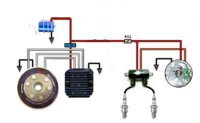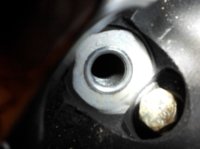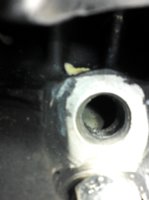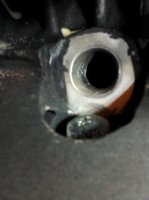Rogue21
XS650 Addict
I am trying to get my project running for the first time and have been having the issue of what seems to be a back flow of gas through the carbs and out the air filters. I am not leaking gas, but I will get the occasional puff of fuel out the air filters when starting and do not know if this if normal. After attempting to start, the inside of the carb bodies (venturi) is coated with fuel.
The bike is also firing on the left cylinder onlly (I switched the left and right spark plug wires and no change occurred). I am wondering if there is a connection between gas in the carb bodies and no ignition in the right cylinder?
Engine is a 1978 with a set of '78 BS38 carbs. Here is the list of what has been done so far:
Engine Rebuild - Bored cylinders, new pistons, new rings, new cam chain, new cam chain slide/tensioner, valves grind and lapped.
Carbs: Cleaned twice, new gaskets, new float valves and seats, Floats set to 24mm, #45 Pilot Jets, #142.5 Main Jets. Synchronized but not balanced, mixture screws are 3.5 turns out.
Cam chain tension was set, valves then set to 0.004" on intake and 0.006" on exhaust.
Currently running pod filters and just headers for the exhaust pipes.
Running Hugh's PMA, with a Pamco Ignition Unit, and a Sparx capacitor.
I've attached a picture of the current wiring set up. Wiring is 14 gauge, connections are either soldered or securely crimped with good ground connections.
BTW, its about 30 degrees F here..Thanks in advance for the help!
The bike is also firing on the left cylinder onlly (I switched the left and right spark plug wires and no change occurred). I am wondering if there is a connection between gas in the carb bodies and no ignition in the right cylinder?
Engine is a 1978 with a set of '78 BS38 carbs. Here is the list of what has been done so far:
Engine Rebuild - Bored cylinders, new pistons, new rings, new cam chain, new cam chain slide/tensioner, valves grind and lapped.
Carbs: Cleaned twice, new gaskets, new float valves and seats, Floats set to 24mm, #45 Pilot Jets, #142.5 Main Jets. Synchronized but not balanced, mixture screws are 3.5 turns out.
Cam chain tension was set, valves then set to 0.004" on intake and 0.006" on exhaust.
Currently running pod filters and just headers for the exhaust pipes.
Running Hugh's PMA, with a Pamco Ignition Unit, and a Sparx capacitor.
I've attached a picture of the current wiring set up. Wiring is 14 gauge, connections are either soldered or securely crimped with good ground connections.
BTW, its about 30 degrees F here..Thanks in advance for the help!






